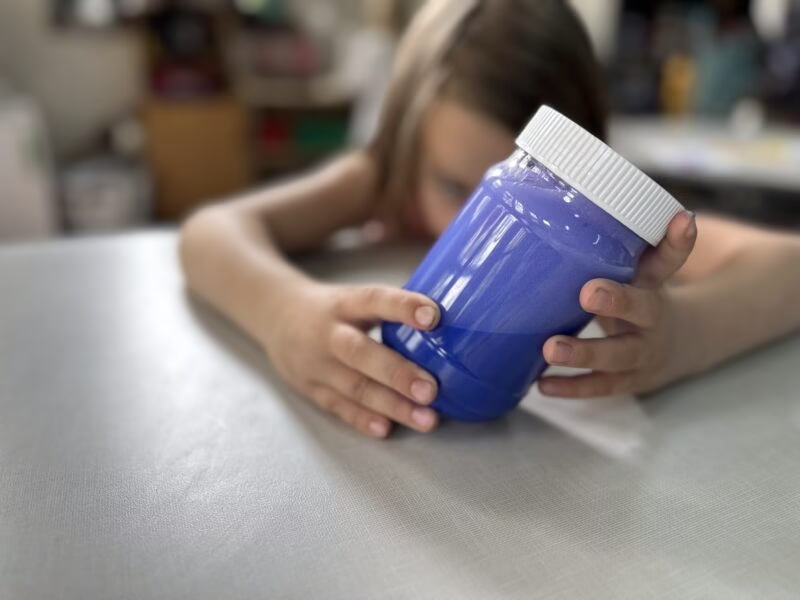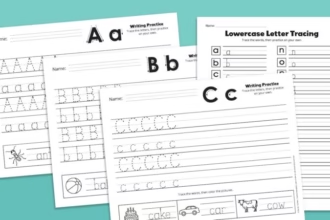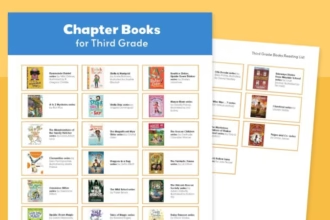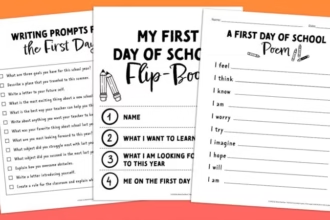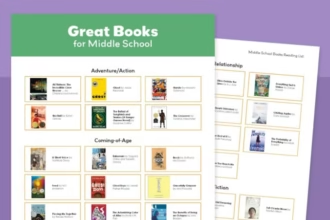Times are tough for kids these days. There are so many issues that are completely out of their control—it really takes a toll on learning. Teaching mindfulness is a great antidote to the stress and anxiety a lot of our kids are feeling. Here are 65 mindfulness activities for kids in preschool through high school to support their well-being.
Jump to:
Mindfulness Activities for Kids in Preschool
1. Fly like an eagle
Combine movement with deep breathing in this exercise. Tell students to imagine an eagle slowly soaring across a wide canyon. As students walk slowly around the classroom, they breathe in as their wings go up and breathe out as their wings go down.
2. Play in a sensory bin
Watch a preschooler at a sensory bin and you’ll see them lost in their own little world. Sensory bins are the perfect tool to give students time to slow down, think, and wonder. Try a bin filled with Epsom salts and glass gems or filled with sand and marbles. There are so many possibilities! Fill the bin with buttons, beads, rice, beans, pasta, birdseed, or anything little hands will find interesting.
Try it: Sensory Bin Ideas for Your Classroom
3. Play with a calm-down jar
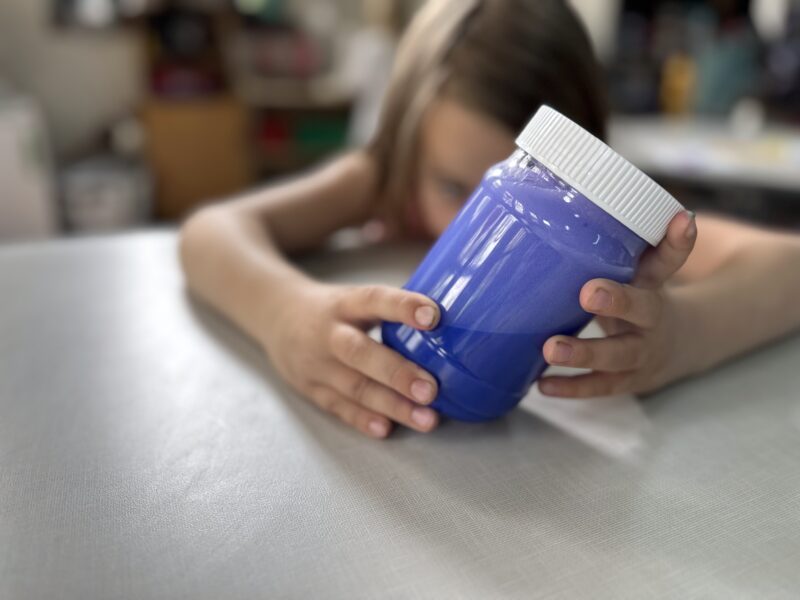
To help kids calm down, have them shake up a calm-down jar and then watch and breathe. You can even add glitter so they can watch until the sparkles settle in the bottom of the jar. Follow the directions in our tutorial linked below, and then add a healthy handful of glitter.
Try it: DIY Calm-Down Jars
4. Paint nature
Nothing calms kids like creating with nature. Collect an assortment of leaves, sticks, and rocks, then let kids use poster paint to embellish their finds. In winter, go outside with watercolors and paint the snow.
Try it: Fun and Easy Nature Crafts and Activities
5. Take a golden moment
Sound is a powerful tool in resetting the nervous system, and this is one of our favorite focusing activities. Ask students to sit at their desks, close their eyes, take a deep breath in and out, then listen carefully. Ring a chime or a Tibetan bowl and ask students to listen very carefully until the very end of the ring. Have them raise their hand when they hear the sound finally subside.
6. Try teddy breathing
Teach your students how to use slow, mindful breathing. Have them lie down on the floor with a stuffed teddy bear or any other animal on their chest. Instruct them to breathe in deeply and watch their stuffy rise, then breathe out and watch it fall. Then see what happens when you breathe slower or faster or hold your breath.
7. Read books
There are dozens of brilliant books that teach the lesson of mindfulness for preschoolers. A couple of our favorites, just for little ones, are Peaceful Like a Panda and I Am the Jungle.
Try it: Books To Teach Kids About Mindfulness
8. Take a listening walk
Teach children to focus and listen carefully as you take them on a listening walk. Inside or out, students can focus on hearing what is around them without making any noise or interacting. When you return to the room, ask them to write or draw all the things they discovered. Or gather together in circle time and let them share.
9. Or better yet, engage all five senses
Help your students focus on the present moment with this simple activity. Have students sit quietly at their desks, or, if you have space, lie on their backs on the floor. Ask them to look around the room in all directions, silently observing all they can see. Then do a 3-2-1 countdown and have students close their eyes. Without moving or making a sound, instruct them to observe anything they smell, hear, taste, or feel.
10. Blow bubbles
Nothing clears the mind (and encourages deep breathing) like good-old bubble blowing. Blow bubbles, then watch how far they go before they pop!
Try it: Fun ways to use bubbles in the classroom
11. Get grounded
Do a “mindful feet” body scan with students. Standing (or sitting) with eyes closed and feet firmly planted, ask students to observe how they feel as you lead them through a series of questions. Visit Blissful Kids for more information.
12. Practice finger tracing
Have students sit quietly and put one hand out in front of them, palm facing in. Starting at the base of the thumb, show them how to trace the outline of their hand up around their thumb and around each finger. As they trace upward, ask them to breathe in. As they trace downward, breathe out.
13. Play in water
Water is an age-old remedy for stress and worry, and sensory water tables are a fantastic way to engage students. Let students rotate through water table activities at center time.
14. Dim the lights
Sometimes something as simple as removing just one source of stimulus in the classroom can help students slow down and be present in the moment. Turning off the lights is one way of doing this (especially if you have obnoxious fluorescent overhead lights). It’s like magic when the lights dim—you can almost feel everyone taking a big breath. Try it next time you have story time, and see if your students follow along with a little more presence.
15. Take a mindful snack break
Snack time often becomes a mad rush to finish as quickly as possible, but it can actually be a time to slow down and savor the moment. Try this: Serve a tasty trail mix with bits like goldfish, dried fruit, nuts (if there are no allergies in your class), etc. Now, guide kids through finding one little piece at a time and ask your preschoolers to mindfully focus on eating it, noticing the size, shape, smell, color, and taste of each.
Mindfulness Activities for Kids in Elementary School
16. Teach kids how to identify their feelings
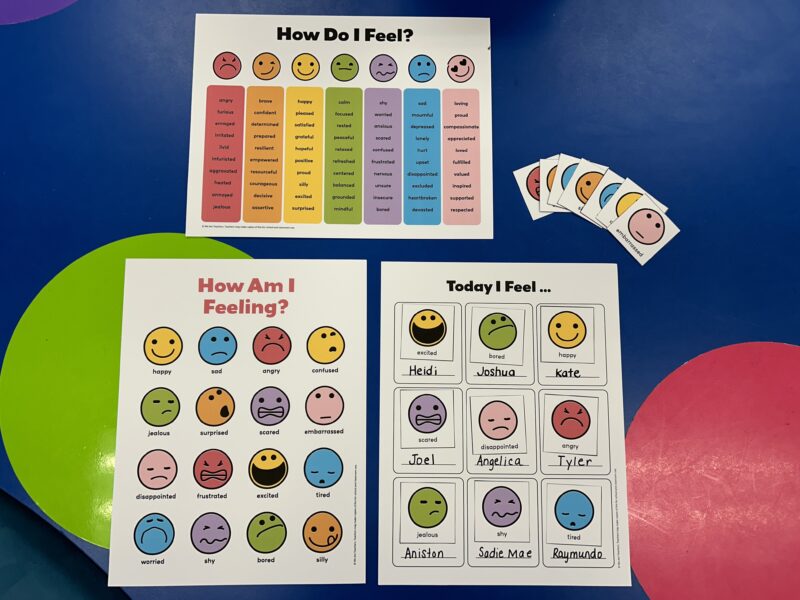
One of the most helpful tools for students to begin practicing mindfulness is the ability to identify their feelings. Download our free bundle of feelings charts to get started.
17. Breathe deeply
Teach kids to calm their thoughts and bodies with mindful breathing in tune with the movement of an object. Ask students to sit quietly at their desks and direct their attention toward you. Have them breathe in as you slowly pull a Hoberman sphere apart until it reaches its full size. As you collapse the sphere, have them breathe out.
18. Listen to your heart
Take a break from classwork and have your students run in place or do jumping jacks for one minute. When the minute is up, ask students to silently put their hands on their chest and feel their heart beat. Alternatively, teach kids how to detect their pulse. Time them for another minute and ask them to keep track of how many heartbeats they can feel.
19. Create a calm-down corner

Designate a safe and cozy space for students to go to whenever they need to recenter and refocus.
Try it: How To Create and Use a Calm-Down Corner and Great Ideas for Your Classroom Calm-Down Kit
20. Practice mindful art
Taking time to create is one of the best mindfulness activities for kids. Many children find peace and relaxation in art. It focuses their minds and helps them look at the world around them in a much more engaged way. Try coloring mandalas, doing leaf rubbings, drawing in sand, or using a mini rake in a sand Zen garden. Any art activity that allows students to get lost in their own creativity has tremendous benefits.
21. Do mind-body exercises
From breathing to listing their favorite things, mind-body exercises are a fun and easy way to bring mindfulness to your classroom.
22. Learn to knit
Not only is knitting a practical craft, it has wonderful benefits on the body. The rhythm of knitting helps release serotonin, the chemical transmitter that helps regulate anxiety, happiness, and mood. There is a strong connection between knitting and the feelings of calm and happiness in the brain. Tip: There are loads of easy beginner knitting videos on YouTube.
23. Build positive self-esteem
Teaching students to speak to themselves in a kind, encouraging way supports positive behavior, helps kids focus and relax, and builds positive self-esteem. Print our free Positive Affirmation Cards and allow students to choose the one that speaks to them that day.
24. Try guided imagery
Help students redirect their busy minds with guided imagery. Choose a quiet place that’s free from interruptions. Ask students to sit quietly and close their eyes. Read a guided imagery script slowly as soft, relaxing music plays in the background.
25. Try balloon breathing
Have students lie down with arms relaxed at their sides and eyes closed. Have them imagine their abdomen is a balloon that inflates bigger and bigger as they inhale deeply. As they exhale, they should feel the balloon slowly deflate. Repeat.
26. Try a Zones of Regulation activity
This simple concept assigns colors to emotions: red (angry, out of control, overjoyed), yellow (worried, anxious, confused), green (calm, happy, focused), and blue (bored, sad, exhausted). Once students have identified what zone they’re in, they can learn the appropriate strategies to manage their feelings.
Try it: Zones of Regulation Activities
27. Just listen
While seated at their desks, have students sit quietly with eyes closed. Ask them to quiet their minds and tune in to what’s going on around them. Set a timer for one minute. They may hear birds outside, the hum of the radiator, or the sound of their own breath. Encourage them to keep thoughts from interrupting their listening. When time is up, have them open their eyes. Ask how their minds and bodies feel compared to before the activity.
28. Go on a color search
Give each student a copy of the color search worksheet in this bundle of mindfulness activities and have them search the classroom (or library, hallway, outdoor space, etc.) to find one item for each color listed on the sheet. The only catch? They must search independently and silently so that everyone can work mindfully.
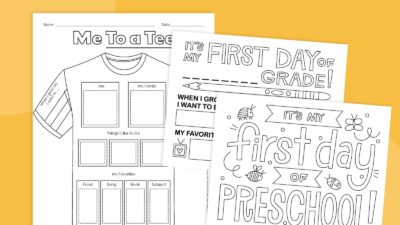
29. Use drawing prompts
Drawing and doodling are great ways to relax the mind and calm the nerves. Provide students with free time for drawing, or offer drawing prompts. For instance, “Draw your happy place” or “Draw your favorite person.”
30. Stretch and refresh
It’s amazing how effective just taking a few moments to silently stretch our bodies is for our energy and attitude.
31. Make time for reflective journaling
Give students time to free-write. Don’t set limits on the content or format of their writing, just encourage them to express themselves any way they choose. They can make lists, write poems or essays or letters they would like to send, or simply jot down words or phrases.
Learn more: Benefits of Journaling for Students (and Teachers!)
32. Use mindfulness writing prompts
Sometimes kids have a hard time coming up with ideas for what to write about. Offer thought-provoking prompts like “Things that make me happy (or sad or angry)” or “If I had five wishes.” Or have them simply make lists of favorite things (people, animals, games, places).
Try it: Writing Prompts for Kids
33. Make worry monsters
Teach your students how to make their very own worry monster. Ask students to bring in a small empty box, like a shoebox or cereal box. First, show students how to cut a mouth hole out of their box. Then, have them add eyes and a nose, ears, and hair if they’d like, and give them time to decorate their box (monster) any way they’d like. Provide creative materials like pom-poms, wrapping paper, yarn, markers, paint, etc. Once they are finished, whenever students have something that makes them sad or worried, they can write it down and feed it to their worry monster.
34. Do some balancing poses
It’s hard to think of much else when you’re focused on not tipping over! Have students balance on one foot or try some balancing yoga poses like tree pose, dancer’s pose, or half moon.
Mindfulness Activities for Kids in Middle School
35. Try a blind taste test
Partner students up and have one put on a blindfold. Then give their partner three pieces of food—for example, a hot Cheeto, a piece of broccoli, and a blueberry. One bit at a time, have the partner (gently) feed the blindfolded student. That student will have to block out everything else as they focus only on the taste in their mouth. Without seeing and touching the food, it may require more focus to identify what they’re tasting.
36. Read storybooks
Think middle schoolers are too old for picture books? Well, think again. Even big kids like to be read to. And many picture books come with excellent mindfulness lessons.
Learn more: How I Use Picture Books To Teach Mindfulness in Middle School
37. Practice yoga
Yoga is a beautiful way to encourage mindfulness, no matter your age. Download our free printable yoga poses to inspire your students to begin.
38. Make a happiness collage
Reflecting on what makes us happy helps us develop a feeling of gratitude for our lives. Ask students to bring in photos, drawings, writings, or other mementos that make them happy. Have them glue their items onto a large piece of construction paper and decorate them.
39. Introduce aromatherapy to your classroom
Aromatherapy with essential oils from the flowers, roots, leaves, seeds, bark, or peel of certain plants can help your students be more present and give them a sense of well-being. Best of all, because they are natural substances, they’re completely safe for all ages. Invest in an inexpensive diffuser for your classroom, play around with different scents, and get students’ input on their favorites.
40. Play Spot the Difference
Ask for one volunteer to be the “spotter.” Ask them to sit in a chair facing one side of the classroom. Then ask for three volunteers to be “changers.” Give the spotter up to one minute to carefully scan the room, as if memorizing the details of the scene. Then have them cover their eyes. Now, have the changers quietly change one detail of the scene. Have the spotter open their eyes and try to name the change. Repeat.
41. Dig in the garden
One of the best mindfulness activities for kids is connecting with the earth and watching things grow. Why not create a school garden? This would be especially great for city kids, who may not have the opportunity to garden very often. Learn how the experience changed one teacher’s life in How One School Garden Transformed a Neighborhood.
42. Go on a mindfulness scavenger hunt
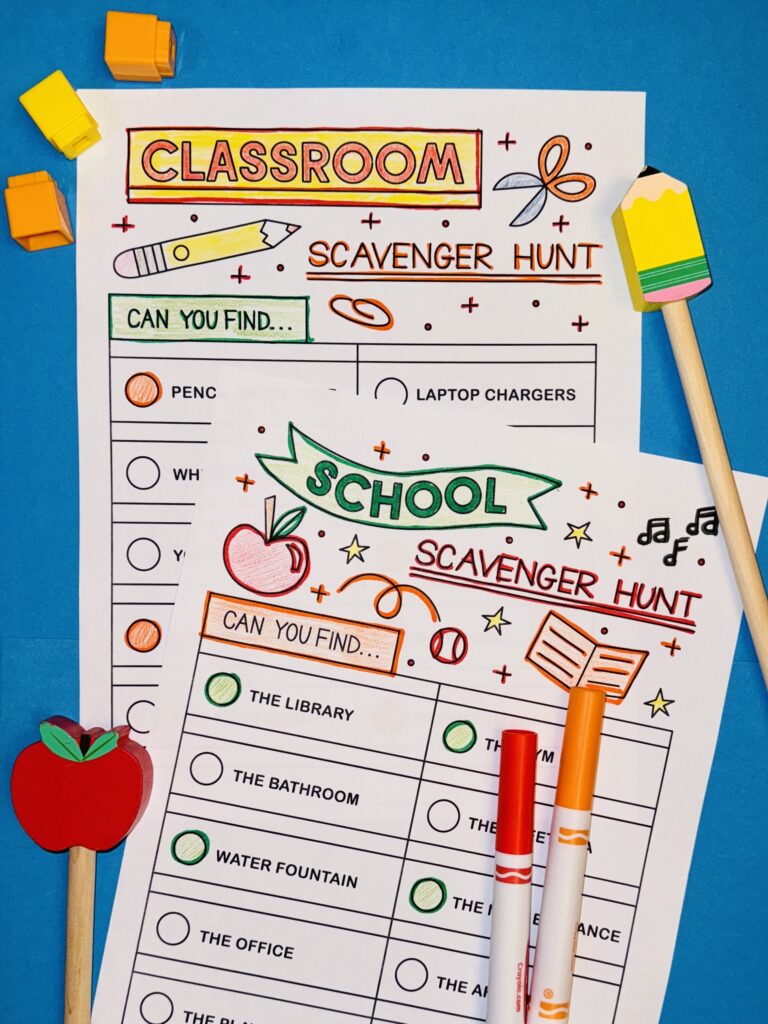
With your students, brainstorm ideas of things they may experience on a nature walk. For instance, clouds in the sky, different surfaces below their feet, different colors, different textures, different masses. Think about what sounds they may encounter outside and what smells they may encounter. Once you brainstorm 20 to 25 items, have students choose 10. Then take them outside and let them wander for a specified period of time to find all of the items on their list.
43. Stack rocks
Although the practice of rock stacking in nature is discouraged by some, it can be a great activity to try indoors. Simply buy a supply of stones from your local craft store and let kids build their tower on a square of cardboard.
44. Do a scribble drawing
This one is so simple yet so satisfying. On a plain piece of white paper, have students use a pen to create an elaborate scribble with lots of curves and turns. Then, using pencils or markers, color in each section with a different color.
45. Relax your muscles
Progressive muscle relaxation (PMR) is a technique that involves tensing and relaxing different muscle groups to relieve tension and induce a relaxation response. It is an effective mindfulness activity, easy to learn, and only takes 10 to 20 minutes.
46. Create self-portraits
This terrific art project encourages kids to think about what makes them unique. After drawing a self-portrait, ask students to surround their drawing with words that describe their personality.
47. Set intentions
When kids take time to set a simple intention for their day, it helps them be more productive. Each morning, set aside two minutes for students to sit quietly, with their eyes closed if they like, and have them think about the number-one thing they would like to achieve today. Have them write their intention on a sticky note and put it on their desk or in a notebook. Encourage them to stop at various points in the day to see if they are on track.
48. Enter class peacefully
Passing periods can be a chaotic experience in middle school and high school. So set the stage for peace and productivity in your class with this simple activity. As students line up to enter your classroom, have each one stop and take a full breath in and out before they silently enter and take their seat. This will provide a mindful transition from the chaos of the hallway to a calm learning environment.
49. Generate kind wishes for yourself
This moment of loving kindness meditation can help spread positive vibes throughout your class. First have students shut their eyes and sit up tall. Ask them to think of one kind wish to send themselves for the day. It may be peace, hope, love, courage, etc. Instruct them to slowly breathe the kind wish deep into their heart, hold, then slowly breathe out, ready to start the day on a positive note.
50. Practice loving kindness toward others
Circle up and have students, one at a time, turn to the neighbor on their right and offer them one heartfelt compliment or a wish for their day.
Mindfulness Activities for Kids in High School
51. Keep a mindfulness journal
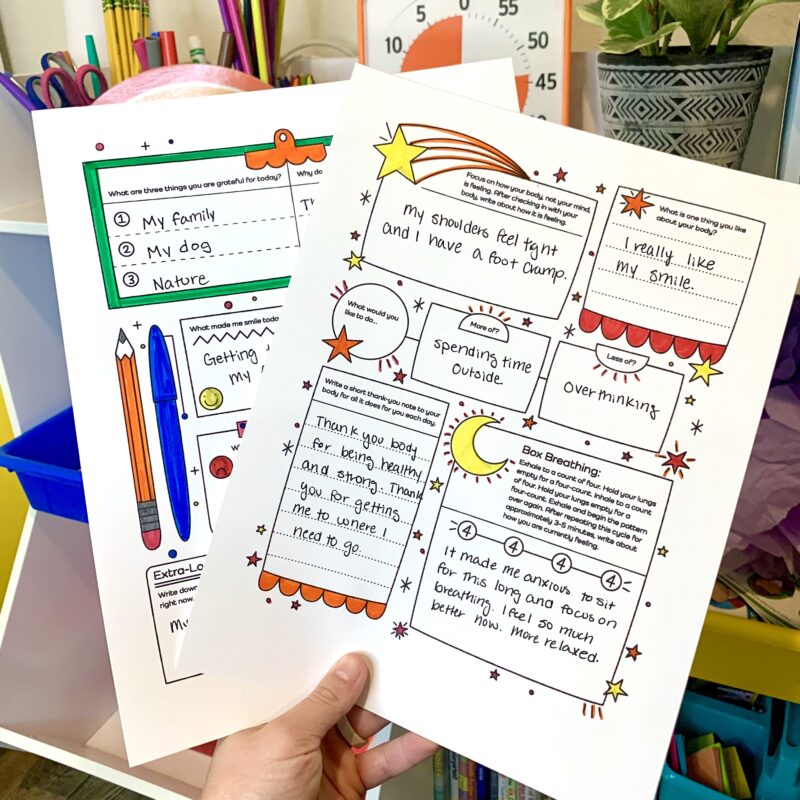
Expressing your thoughts and emotions in a journal is a lifelong strategy that promotes mindfulness. Download this free mindfulness journal to get started.
52. Practice five-finger gratitude
Have students simply take a moment to count out one thing they’re grateful for on each finger. You’ll be surprised how it changes their attitude to one of gratitude. Try this and three other Mindfulness Practices for Your High Schoolers, plus sign up for a free mindfulness course.
53. Support mindfulness with good books
Appropriately written self-help books can provide students with the building blocks of mindfulness. Check out Be More Yoda: Mindful Thinking From a Galaxy Far Far Away by Christian Blauvelt or The Self-Compassionate Teen by Karen Bluth.
54. Color mandalas
Even big kids can get the therapeutic benefits of zoning out with a coloring book. Try handing out copies of mandalas and give students time to check out and create something beautiful. Incidentally, mandala coloring has been shown to promote relaxation and foster concentration.
55. Have a lava lamp on hand

We all know the trance-inducing effects of lava lamps. Pick a quiet corner in your classroom for students to retreat to and take a few moments to simply sit and stare. Or better yet, make your own lava lamp. Simply fill a jar or bottle with water and oil. Add food coloring, then add a fizzing tablet.
56. Try 4-7-8 breathing
A simple breathing technique to center yourself and calm your nervous system, the 4-7-8 breathing technique helps to provide a mindful moment through the experience of intentional breathing. To start, first get comfortable. Sit or lie down, then breathe through your nose for four seconds. Hold your breath for seven seconds. Then, breath forcefully out for eight seconds. Try doing multiple cycles of 4-7-8 breathing over the course of a few minutes.
57. Adapt students’ screen time
It’s hard to be mindful when you’re constantly bombarded with input. From tracking screen time to phone-free Fridays, there are many ways to encourage our teens to disconnect from screen time.
Learn more: How Schools Are Bringing Commonsense Mindfulness to Screen Time
58. Teach the STOP method
The STOP method is a wonderful grounding exercise that helps students reconnect to themselves whenever they are stressed or feeling strong emotions. Here’s how it works, in four simple steps: (S) stop, (T) take a breath, (O) observe your body, and (P) proceed with your day.
59. Try dance therapy
Dancing brings important mental health benefits such as stress reduction and symptom relief for anxiety and depression. Turn on your favorite playlist and give students five minutes to move and groove.
Try it: Classroom Spotify Playlists and Artist Recommendations
60. Download mindfulness apps
There are loads of mindfulness apps to help teens find balance.
Try it: Best Apps To Combat Anxiety and Stress
61. Soothe the senses with music
Music has many benefits for the mind. Play classical music during work time in the classroom. Or look up Zen playlists on Spotify to help students focus and create.
Try it: Best Classical Music for Kids and Teens
62. Set daily goals

Setting goals is important for people of all ages, no matter how big or small the goal. We all need some encouragement to help us turn our dreams into reality. Start goal-setting with your class with this list of our favorite goal-setting quotes, perfect for using as writing or discussion prompts.
63. Use guided imagery
Ask your students to sit quietly and close their eyes. Then guide them through a mindful visualization in a calm and gentle voice. Try this teen-appropriate guided imagery script from Compassionate Counseling.
64. Practice positive self-talk
Teens are nice when they talk to their friends, so it stands to reason they should be nice when they talk to themselves too!
65. Try Zentangles
Zentangles are such a delicious way to zone out and calm your nerves. There are loads of video tutorials available online, or pick up an instructional book and tear the pages out to share with students.


